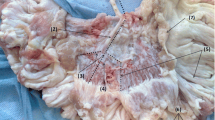Summary
In the present study the relationship between adrenergic nerve terminals and postjunctional α-adrenoceptors mediating the responses to the endogenous transmitter was compared at proximal and distal levels of the canine saphenous vein.
Concentration-response curves to noradrenaline and to tyramine as well as frequency-response curves to electrical stimulation were compared at both levels of the vessel, in the absence and presence of either prazosin (100nmol·l−1) or yohimbine (100nmol·l−1) The influence of inhibition of neuronal uptake by cocaine (12 µmol·l−1) on the responses to noradrenaline in the presence of prazosin (56 nmol·l−1) or yohimbine (20 nmol·l−1) was compared at the proximal level. The results show that, at the proximal level, the maximal responses to electrical stimulation and tyramine reached 80.1±2.2 (n = 18) and 74.2±1.9 (n = 18)%, respectively, of the maximal responses to noradrenaline, and 70.3±0.8 (n = 15) and 53.1 ± 1.2 (n = 14) %, respectively, at the distal level. Furthermore, the proximal strips were more sensitive to electrical stimulation than the distal ones. Prazosin had a much greater inhibitory effect on the contractile responses to noradrenaline than on those to electrical stimulation, at both levels. At proximal level, the shifts (to the right) of the concentration (frequency)-response curves (at EC50) amounted to 0.58±0.02 (n = 16) and 0.18±0.02 (n = 8) log units, respectively (P<0.05), but, at the distal level, to 1.12±0.03 (n = 16) and 0.28±0.08 (n = 8) log units, respectively (P< 0.05). At the proximal level, yohimbine antagonizes about equally the responses to noradrenaline and the responses to electrical stimulation. However, at the distal level, the shift of the concentration-response curve to noradrenaline was much larger than that of the frequency-response curve to electrical stimulation [1.12±0.07 and 0.80±0.10 (n = 6) log units at EC50, respectively (P<0.05)]. The leftward shift of the concentration-response curve to noradrenaline caused by cocaine was more pronounced in the presence of prazosin than in the presence of yohimbine: 0.95±0.15 and 0.69±0.12 (n = 12) log units, respectively (P<0.05).
We conclude that, in the canine saphenous vein: 1) noradrenaline released from the adrenergic nerve terminals by electrical stimulation and by tyramine preferentially activates α2-adrenoceptors at both proximal and distal levels; 2) the effectiveness of α2-adrenoceptor stimulation is greater at the proximal than at the distal level; 3) α1-adrenoceptors at the distal level seem to be different from those at the proximal one.
Similar content being viewed by others
References
Brandão F, Guimarães S (1974) Inactivation of endogenous noradrenaline released by electrical stimulation in vitro of dog saphenous vein. Blood Vessels 11:45–54
De Mey JC, Vanhoutte PM (1981) Uneven distribution of postjunctional alpha1- and alpha2-like adrenoceptors in canine arterial venous smooth muscle. Circ Res 48:875–884
Docherty JR, Hyland L (1985) Evidence for neuro-effector transmission through postjunctional a2-adrenoceptors in human saphenous vein. Br J Pharmacol 84:573–576
Flavahan NA, Rimele TJ, Cooke JP, Vanhoutte PA (1984) Characterization of postjunctional alpha,- and alpha2-adrenoceptors activated by exogenous or nerve-released norepinephrine in the canine saphenous vein. J Pharmacol Exp Ther 230:699–750
Guimarães S (1982) Two adrenergic biophases in blood vessels. TIPS 3:159–161
Guimarães S, Nunes JP (1990) The effectiveness of α2-adrenoceptor activation increases from the distal to the proximal part of the veins of canine limbs. Br J Pharmacol 101:387–393
Guimarães S, Osswald W (1969) Adrenergic receptors in the veins of the dog. Eur J Pharmacol 5:133–140
Guimarães S, Paiva MQ (1981a) Two distinct adrenoceptor-biophases in the vasculature: one for α- and the other for β-agonists. Naunyn-Schmiedeberg's Arch Pharmacol 316:195–199
Guimarães S, Paiva MQ (1981 b) Two different biophases for adrenaline released by electrical stimulation or tyramine from the sympathetic nerve endings of the dog saphenous vein. Naunyn-Schmiedeberg's Arch Pharmacol 316:200–204
Guimarães S, Trendelenburg U (1985) Deviation supersensitivity and inhibition of saturable sites of loss. TIPS 6:371–374
Guimarães S, Paiva MQ, Brandão F (1978) The study of the adrenoceptor-mediated feedback mechanisms by using adrenaline as a false transmitter. Naunyn-Schmiedeberg's Arch Pharmacol 305:185–188
Guimarães S, Paiva MQ, Polónia JJ (1983) Alpha1- and alpha2-adrenoceptors of the dog saphenous vein and their relation to the sympathetic nerve terminals. Prog Neuropsychopharmacol Biol Psychiatry [suppl]:155 (abstr)
Kenakin TP (1984) The classification of drugs and drug receptors in isolated tissues. Pharmacol Rev 36:165–222
Langer SZ, Shepperson NB (1982) Recent developments in vascular smooth muscle pharmacology: the post-synaptic α2-adrenoceptor. TIPS 3:440–444
Ruffolo RR Jr, Waddel JE, Yaden EC (1982) Heterogeneity of postsynaptic alpha adrenergic receptors in mammalian aortas. J Pharmacol Exp Ther 221:309–314
Sokal RR, Rohlf FJ (1981) Biometry. The principles and practice of statistics in biological research. Freeman, New York
Starke K (1981) α-Adrenoceptor subclassification. Rev Physiol Biochem Pharmacol 88:199–236
Starke K, Montel H (1973) Influence of drugs with affinity for alpha-adrenoceptors on noradrenaline release by potassium and tyramine. Proceedings 2. Meeting on Adrenergic Mechanisms, Porto, pp 53–54
Sullivan AT, Drew GM (1980) Pharmacological characterization of pre- and postsynaptic α-adrenoceptors in dog saphenous vein. Naunyn-Schmiedeberg's Arch Pharmacol 314:249–258
Trendelenburg U (1988) The extraneuronal uptake and metabolism of catecholamines. In: Trendelenburg U, Weiner N (eds) Catecholamines. Springer, Heidelberg (I. Handbuch Exp Pharmacol 90 I), pp 279–319
Wilffert B, Timmermans PBMWM, Van Zwieten PA (1982) Extrasynaptic location of alpha-2 and noninnervated beta-2 adrenoceptors in the vascular system of the pithed normotensive rat. J Pharmacol Exp Ther 221:762–768
Yamaguchi I, Kopin IJ (1980) Differential inhibition of alpha-1 and alpha-2 adrenoceptor-mediated pressor responses in pithed rats. J Pharmacol Exp Ther 214:275–281
Author information
Authors and Affiliations
Additional information
Send offprint requests to S. Guimarães at the above address
Rights and permissions
About this article
Cite this article
Pereira, O., Moura, D., Nunes, P. et al. Involvement of α1- and α2-adrenoceptors in the responses of proximal and distal segments of the canine saphenous vein to exogenous and endogenous noradrenaline. Naunyn-Schmiedeberg's Arch Pharmacol 343, 616–622 (1991). https://doi.org/10.1007/BF00184293
Received:
Accepted:
Issue Date:
DOI: https://doi.org/10.1007/BF00184293



